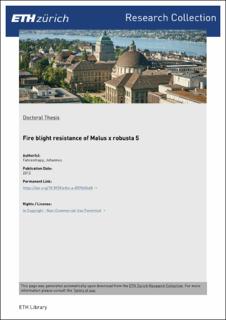Please use this identifier to cite or link to this item:
https://doi.org/10.21256/zhaw-1824Full metadata record
| DC Field | Value | Language |
|---|---|---|
| dc.contributor.advisor | Gessler, Cesare | - |
| dc.contributor.advisor | McDonald, Bruce | - |
| dc.contributor.advisor | Peil, Andreas | - |
| dc.contributor.author | Fahrentrapp, Johannes | - |
| dc.date.accessioned | 2018-03-20T15:24:45Z | - |
| dc.date.available | 2018-03-20T15:24:45Z | - |
| dc.date.issued | 2012 | - |
| dc.identifier.uri | https://digitalcollection.zhaw.ch/handle/11475/4098 | - |
| dc.description.abstract | Fire Blight (FB) is the most important bacterial disease in apple (Malus × domestica) and pear (Pyrus communis) production. The application of resistant cultivars would be an additional measure against FB limiting the dependence on antibiotic treatments and the dormant risk for producers to lose their only effective control measure. However, today there is no popular FB resistant apple variety available. Strong quantitative trait loci (QTLs) for resistance were identified e.g. in the wild apple ‘Malus × robusta 5’ (MR5). The present work aimed firstly to provide usable molecular markers tightly linked to the resistance locus of MR5 and secondly to isolate and characterize the source of MR5 resistance against Erwinia amylovora. 14 new molecular markers were developed and mapped to the top of linkage group (LG) 3 of MR5 containing the resistance locus. Together, they defined the distal 1.5 cM of LG 3 of MR5. After phenotyping of recombinant individuals of an expanded population of more than 2000 individuals segregating for MR5 resistance, the locus of the resistance trait was flanked by two markers defining an interval of 0.23 cM. By means of chromosome landing two bacterial artificial chromosomes (BACs) harboring the genomic DNA of MR5 were identified, one of which was in coupling and one in repulsion to the alleles of the flanking markers. Using differently trained protein prediction software (FGENESH) 25-47 open reading frames (ORFs) were predicted on the assembled sequences derived from the resistance carrying BAC. The predicted mRNAs were annotated and compared to the constitutional transcriptome of MR5 to evaluate the prediction algorithms. The annotation and subsequent motif analysis led to the identification of one candidate resistance (R) gene named FB_MR5. We investigated the candidate resistance gene, which was demonstrated to be constitutionally expressed in MR5 as well as in resistant progenies of MR5, but not in susceptible cultivars (‘Idared’, ‘La Flamboyante’, ‘Gala’) and susceptible progenies of MR5. FB_MR5 was cloned and resequenced. FB_MR5 was classified in silico as CC-NBS-LRR protein (CNL, coiled coil nucleotide binding site leucine rich repeat). All investigated CNLs giving resistance towards bacterial diseases function in accordance to the ‘decoy model’ or ‘guard model’ which postulate the interaction of (1) the R protein of the host, which recognizes conformational changes or degradation of (2) the ‘decoy’/‘guardee’ protein interacting with (3) the bacterial effector (Avr protein). Taking into account the recently published findings on host-microbe interactions in other plants and the presence and absence, respectively, of transcribed putative decoys/guardees in MR5 transcriptome as well as the presence and absence, respectively, of Avr genes in E. amylovora, we hypothesized a homologous mode of function of FB_MR5 to RPS2 of Arabidopsis thaliana. Finally, to give evidence to the functionality of FB_MR5 acting as R gene against FB, a complementation assay into susceptible cultivar ‘Gala’ was appended as preliminary results in this thesis. Two constructs comprising FB_MR5 under the control of CaMV 35s promoter and its own promoter, respectively, were cloned into ‘Gala’ via Agrobacterium tumefaciens. 24 newly developed transgenic shoots are growing to a usable size for micro grafting on M9 rootstocks and will later be inoculated with E. amylovora. | de_CH |
| dc.format.extent | 119 | de_CH |
| dc.language.iso | en | de_CH |
| dc.publisher | ETH Zürich | de_CH |
| dc.rights | Licence according to publishing contract | de_CH |
| dc.subject | Genetic engineering | de_CH |
| dc.subject | Gene mapping | de_CH |
| dc.subject | Transcriptome | de_CH |
| dc.subject | Erwinia amylovora | de_CH |
| dc.subject.ddc | 634: Obstanlagen, Früchte und Forstwirtschaft | de_CH |
| dc.subject.ddc | 660.6: Biotechnologie | de_CH |
| dc.title | Fire blight resistance of Malus x robusta 5 | de_CH |
| dc.type | Dissertation | de_CH |
| dcterms.type | Text | de_CH |
| zhaw.departement | Life Sciences und Facility Management | de_CH |
| zhaw.organisationalunit | Institut für Umwelt und Natürliche Ressourcen (IUNR) | de_CH |
| zhaw.publisher.place | Zürich | de_CH |
| dc.identifier.doi | 10.21256/zhaw-1824 | - |
| dc.identifier.doi | 10.3929/ethz-a-007563465 | de_CH |
| zhaw.originated.zhaw | Yes | de_CH |
| zhaw.webfeed | Hortikultur | de_CH |
| Appears in collections: | Publikationen Life Sciences und Facility Management | |
Files in This Item:
| File | Description | Size | Format | |
|---|---|---|---|---|
| 2012_Fahrentrapp_Fire_blight_resistance.pdf | 20.72 MB | Adobe PDF |  View/Open |
Show simple item record
Fahrentrapp, J. (2012). Fire blight resistance of Malus x robusta 5 [Doctoral dissertation, ETH Zürich]. https://doi.org/10.21256/zhaw-1824
Fahrentrapp, J. (2012) Fire blight resistance of Malus x robusta 5. Doctoral dissertation. ETH Zürich. Available at: https://doi.org/10.21256/zhaw-1824.
J. Fahrentrapp, “Fire blight resistance of Malus x robusta 5,” Doctoral dissertation, ETH Zürich, Zürich, 2012. doi: 10.21256/zhaw-1824.
FAHRENTRAPP, Johannes, 2012. Fire blight resistance of Malus x robusta 5. Doctoral dissertation. Zürich: ETH Zürich
Fahrentrapp, Johannes. 2012. “Fire Blight Resistance of Malus X Robusta 5.” Doctoral dissertation, Zürich: ETH Zürich. https://doi.org/10.21256/zhaw-1824.
Fahrentrapp, Johannes. Fire Blight Resistance of Malus X Robusta 5. ETH Zürich, 2012, https://doi.org/10.21256/zhaw-1824.
Items in DSpace are protected by copyright, with all rights reserved, unless otherwise indicated.